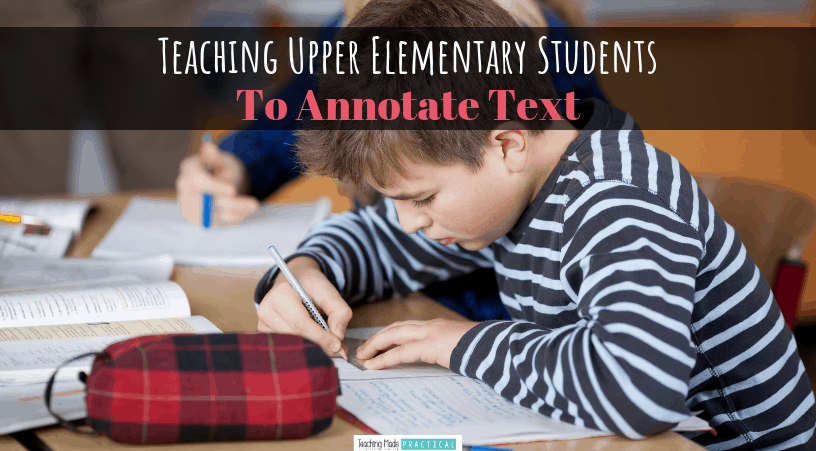
Written by Guest Blogger Jessica Thompson
I remember telling my class we were going to annotate the text. Wait. We are going to anno-what?
Very simply put, to annotate is to take notes or add comments. For students in third, fourth, and fifth grade, learning to annotate the text they are reading will be an imperative skill as they get into middle school, high school, and beyond.
It will help them develop proper study skills, connect to and remember the text, as well as learn to track their own thinking. They will comprehend at a deeper level. It’s a skill that is often overlooked and students are expected to know how to do, but one that we should model to guide them towards success.
Beginning to Annotate Text in Upper Elementary
Students can track their thinking by writing in the margins of the text (if it is a consumable) or do their note-taking in a notebook as they read.
As you begin to teach annotations to students be sure to keep it simple. Start with writing down important facts, thoughts, questions, and unknown words. The students can look up the unknown words at a later time.
Make sure upper elementary students understand why they should annotate. They should be able to explain that it is a way for them to better understand the text and develop a deeper understanding of their thinking. It is also a great way for students to monitor their own comprehension.
Be sure to discuss how students tracked their thinking while reading, so they will get ideas from each other. As you teach new skills in class, apply these to the annotations as well. For instance, if you are teaching main idea, have students identify details that support the main idea. Theme, character traits, problem and solution, etc. The opportunities for students to annotate is endless!
Scaffolding for Student Success
Annotating text will seem tedious to 3rd, 4th, and 5th grade students as they first begin, but soon you will see the quality and the amount that they are writing in those margins increase.
Model annotating text first to ease the students’ minds. Then, annotate together before you let them try it on their own. This gradual release will have them feeling confident as they track their thinking.
After the students get in a routine of annotating, give them a passage to annotate with comprehension questions. They will annotate the text as they read (and reread hopefully!) then go to the questions. They will see the value in annotating when they realize the notes they took helped them answer the questions. Some of the notes may even be the answers they needed. When students begin to have aha moments, let them share their insight with the class.
Shake it Up and Make Annotations Fun
- Use different colored pens. Let the students pick their favorite color, or all the colors, to do their annotations. Kids love having a choice and this gives them some freedom. Your visual learners will love this!
- Use post its. If you are using a text book or library book that cannot be written in, then use post it notes to stick on the pages. No post its? No problem. Let student’s take notes on construction paper or colored computer paper.
- Take a grade. This seems silly and so not fun, but when students realize that they can get a good grade annotating text, it really boosts them up. Their annotations should connect to the skills you are working on in class for it to make sense to take a grade. If you are teaching problem and solution, then their notes should identify the problem and events leading to the solution.
- Science. Seriously, science period. Annotations are not just for reading class, so find an excerpt, a poem, a story, or an article that goes along with the topic being taught in science class and let the students get to work.
- Choose your own text. Have a few options of articles, short stories, or poetry for students to choose from and let them annotate. Students will like choosing a genre and topic that they enjoy. Have options from sports, animals, and any other interesting topics that you know your students will enjoy.
As students get more confident annotating the text, you will begin to notice them doing it on their own. Yay! They will begin to annotate cold reads, homework, and tests and you will jump for joy as a teacher. The biggest challenge is time. Do not make annotations a separate lesson, but instead incorporate annotations into what you are already doing. Use text that you are already using in class. Work smarter not harder and you will see the benefits of annotating text through your students’ comprehension and higher level thinking.
Want This Constructed Response Freebie?

